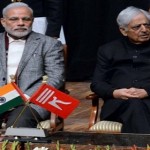The outcome of the November-December 2014 elections in Jammu and Kashmir (J&K)—where the People’s Democratic Party, backed by the Muslim-majority Srinagar Valley and the Bharatiya Janata Party won 28 and 25 seats respectively out of 87—was their surprising decision to form a “governance alliance”. Equally unexpected was the Afghan unity government strung together in September 2014 by the U.S. comprising Abdullah Abdullah, popular among the Hazara Shia community and Ashraf Ghani, backed by the Pashtun Sunni community.
Both are part of an emerging global trend in coalition-formation.
An entrenching of representative democracy and the growth of social media has provided a voice to populations diversified along ideological, religious and ethnic lines, and encouraged their multiple representatives to rule.
Although coalitions have been part of government-formation across the world for many years, bringing together parties with opposing agendas in a grand coalition is a relatively newer development.
These often include parties from opposite ends of the spectrum, such as those between diverse ethnic groups in Afghanistan or multiple religious identities, such as the BJP-PDP goverment. Such unlikely alliances can result in early breakdowns, but they could also hold the key to mainstream policies such as BJP-PDP’s Common Minimum Programme which contain elements that are more acceptable to both parties.
The coalitions in Afghanistan and J&K have much in common. In both cases, it took eight weeks after the election results for differences to be minimised and a common agenda to be established.
Both Afghanistan and J&K have long been impacted by insurgency and terrorism, and both governments are now at the forefront for rejuvenating their economies and building infrastructure.
The similarities run even deeper.
Coalitions across religious or ethnic lines can often lead to a politics of appeasement or create deadlocks. . In Afghanistan, bringing representation to both the majority Sunni Pashtun and minority Shia Hazara communities, is powerful and positive, but could also taint every issue in ethno-communal hues. This is probably why Kabul has not yet been able to put a full cabinet in place despite a power-sharing agreement.
The BJP and PDP will also have to grapple with the phenomenon of policy-making, assuming religious undertones—for instance, in the case of the Armed Forces Special Powers Act that is more resented by Muslims in the Srinagar valley.
Another parallel between the Afghanistan and J&K governments is the divide between coalition partners on anti-government entities. In Afghanistan, Abdullah and Ghani have taken opposing positions vis-à-vis dialogue with the Taliban.
In J&K, the BJP’s refusal to engage with separatists is at odds with the PDP’s demand for dialogue with members of the Hurriyat Conference, and with Pakistan. Barely a month after taking office, the two parties are already divided on the release of imprisoned separatist leader Masarat Alam, resulting in a curt warning issued by the BJP to the PDP about its “unilateral action”.
However, a bigger destabilising factor for both these governments will be the role of Pakistan. The insurgencies in both these parts of the world were born of Pakistani interference—stemming from its search for strategic depth in Afghanistan and to a territorial claim to the whole of J&K.
Despite Islamabad being the longtime contributor to terrorism in Afghanistan—something its civilian governments and military dictatorships have been unwilling to prevent—Ghani is now seeking to strike deals with Pakistan. It’s complicated: while the Pashtuns of Afghanistan have ethnic affinities with Pakistan, the recognition of the Durand Line (drawn in 1893 to demarcate British India from Afghanistan) has been rejected by every single Afghan government, even as Islamabad wants it to be recognized as the international border.
Meanwhile, Pakistan has broadcast its claims over J&K loudly and endlessly. Its use of cross-border terrorism to destabilise and divide on religious lines is now recognised by the international community. Newly sworn-in chief minister Mufti Muhammad Sayeed’s apparent expression of thanks to Pakistan for not disrupting the electoral process in the state, reveals its subversive influence in J&K.
Both the BJP-PDP and Afghan unity government coalitions find themselves at an important juncture. They have the opportunity to expand common ground by narrowing their differences and in doing so, carry their respective electorate with them. But these coalitions could also fall apart if partners reject compromise, and act unilaterally.
For both sets of governments, much depends on Pakistan’s overwhelming capacity to play spoiler. Islamabad could catalyse a complete descent into chaos in both these cases; but it could also choose to play a non-disruptive role, considering it is now a victim of its own terror machine.
In either case, these governments are now part of a pragmatic new global trend, that expands the scope for narrowing differences through creative compromise.
Karan Pradhan is a Senior Researcher at Gateway House: Indian Council on Global Relations.
This article was exclusively written for Gateway House: Indian Council on Global Relations. You can read more exclusive content here.
For interview requests with the author, or for permission to republish, please contact outreach@gatewayhouse.in.
© Copyright 2015 Gateway House: Indian Council on Global Relations. All rights reserved. Any unauthorized copying or reproduction is strictly prohibited


